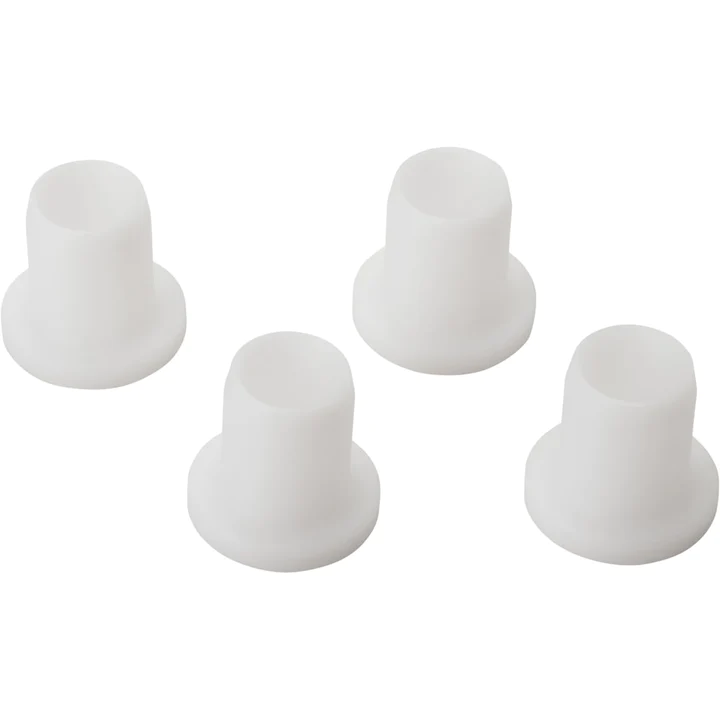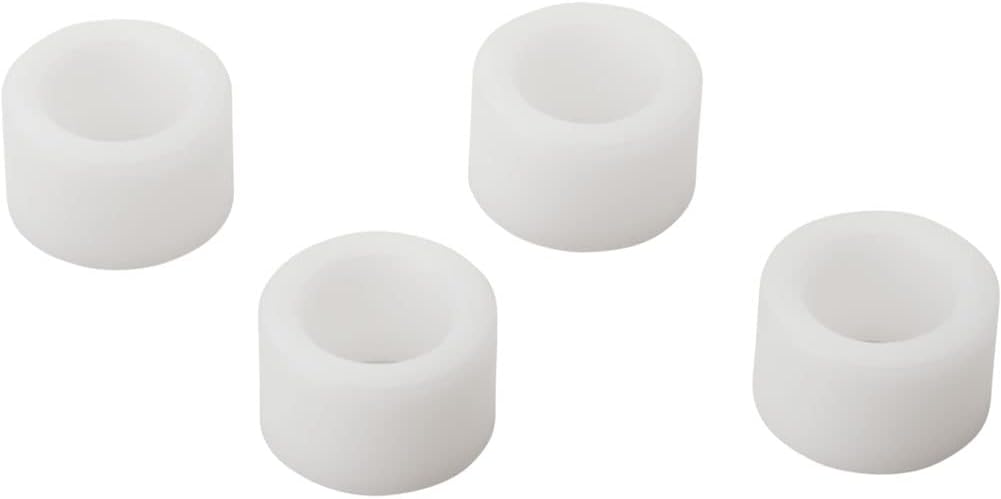Product Description
Plastics Uhmw-Pe bushing with wear resistance
UHMW-PE(Ultra high Molecular Weight Polyethylene )is a thermoplastic engineering plastic with the average molecular weight more than 9.0 million. (PE only has the molecular weight between 20 to 2 hundred thousand. ) This kind of material with 5 top performance of high-wear-resistance, good-chemical resistance, low-temperature resistance, self-lubrication and high-impact resistance, which is regarded as a “surprised” engineering plastic of excellent comprehensive capacity and competitive price.
Main characteristics:
1. Very high-wear resistance, 7 times wear resistance than steel, 4 times than PTFE
2. Very high anti-impact resistance, 2 times impact resistance than PC, 5 times than ABS.
3. Good self-lubrication, the same as PTFE, better than steel and brass appended lubricating oil.
4. Good anti-corrosion resistance, it has very stable chemicals property and can endure the corrosion of all kinds of corrosive medium and organic solvent in certain rang of temperature and humidity.
5. Very high-inadhesion resistance, the surface of product hardly affixes other material.
6. Very high-impact resistance, 10 times impact resistance than PA66, 8 times than PTFE.
7. Good low temperature resistance, in liquefied nitrogen (- 196º C), it still has the prolongation.
Few other materials can reach to this performance.
8. Non-toxic and clean property, UHMW-PE, which is the material that Food and Drug Administration (FDA) and United States Department of Agriculture (ASDA) permit to apply in food and medicine fields.
| Property | Item No. | Unit | Value | |
| Mechanical Properties | 1 | Density | g/cm3 | 0.94-0.96 |
| 2 | average molecular weight | g/mol | More than 9.0 million | |
| 3 | Tensile strength (23ºCin air) | MPa | 22 | |
| 4 | Breaking strength | MPa | 42 | |
| 5 | Tensile strain at break | % | 600 | |
| 6 | Charpy impact strength (notched) | mJ/mm 2 | No break | |
| 7 | Ball indentation hardness | N/mm 2 | 42 | |
| 8 | Shore D hardness | — | D65 | |
| 9 | Abrading(sand slurry experiment) | — | 100 | |
| Material: | PE |
|---|---|
| Size: | According to Drawing or Sample |
| Color: | White, Black, Green, Yellow, Blue, Red |
| Tooling: | CNC Lathe |
| Transport Package: | Packing in Paper Carton and Wooden Pallet |
| Specification: | RoHS, FDA |
| Customization: |
Available
| Customized Request |
|---|

Can UHMW bushings be used in applications with tight tolerances and precision requirements?
Yes, UHMW (Ultra-High Molecular Weight Polyethylene) bushings can be used in applications with tight tolerances and precision requirements. Here’s a detailed explanation:
While UHMW is known for its excellent wear resistance and other beneficial properties, it’s important to consider certain factors when using UHMW bushings in applications with tight tolerances and precision requirements:
1. Machining and Tight Tolerances:
UHMW material can be machined to achieve tight tolerances and precise dimensions. However, it’s important to note that UHMW has a relatively high coefficient of thermal expansion compared to metals. This means that the dimensions of UHMW bushings can be affected by temperature changes. Proper consideration and compensation for thermal expansion are necessary when designing and machining UHMW bushings for applications with tight tolerances.
2. Dimensional Stability:
UHMW exhibits good dimensional stability under normal operating conditions. It has a low moisture absorption rate, which helps to maintain its shape and dimensions over time. This dimensional stability is important for maintaining the tight tolerances required in precision applications.
3. Low Friction and Low Stick-Slip:
UHMW bushings have a low coefficient of friction and low stick-slip characteristics. Stick-slip refers to the jerky or erratic motion that can occur when there is a difference between static and dynamic friction. The low friction and low stick-slip properties of UHMW bushings contribute to smooth and precise movement, making them suitable for applications with precision requirements.
4. Load-Bearing Capability:
UHMW bushings have good load-bearing capabilities, particularly in applications with moderate to low loads. However, it’s important to consider the specific load requirements and consult the manufacturer’s guidelines to ensure that the selected UHMW bushings can handle the intended loads within the required tolerances.
5. Compatibility with Mating Surfaces:
UHMW bushings are compatible with a variety of mating surfaces, including metals, plastics, and composites. This versatility allows for compatibility with different components and mating materials, contributing to the precision and performance of the overall system.
When utilizing UHMW bushings in applications with tight tolerances and precision requirements, it’s crucial to carefully evaluate the specific requirements of the application, consider thermal expansion effects, ensure proper machining and installation techniques, and consult with manufacturers or engineering experts when necessary. By taking these factors into account, UHMW bushings can provide reliable performance and meet the precision demands of the application.

What are the maintenance and installation guidelines for UHMW bushings?
Maintenance and installation guidelines for UHMW (Ultra-High Molecular Weight Polyethylene) bushings are important to ensure their proper functioning and longevity. Here’s a detailed explanation:
1. Proper Handling:
Handle UHMW bushings with clean hands or gloves to prevent contamination. Avoid dropping or mishandling the bushings, as this can cause damage or deformations that may affect their performance.
2. Cleaning:
Regularly clean the UHMW bushings to remove dirt, debris, or contaminants that may accumulate over time. Use a mild detergent or a solution of water and soap to clean the bushings. Avoid using harsh chemicals or solvents that can degrade or damage the UHMW material.
3. Lubrication:
UHMW bushings have inherent self-lubricating properties, but in certain applications or operating conditions, additional lubrication may be necessary. Consult with the manufacturer or supplier for lubrication recommendations specific to your application. If lubrication is required, use lubricants compatible with UHMW and follow the recommended application methods and intervals.
4. Installation:
Follow proper installation procedures to ensure the correct fit and alignment of UHMW bushings. Consider the following guidelines:
- Ensure that the shaft or pivot surface is clean and free from burrs or sharp edges that could damage the bushing.
- Inspect the bushings for any visible defects or damage before installation. Do not install damaged bushings.
- Apply a controlled force or use appropriate tools to press or slide the UHMW bushings into position. Avoid excessive force that could cause deformation or stress concentration.
- Verify that the bushing is securely seated and properly aligned with the shaft or pivot. Check for smooth rotation or movement without binding or excessive play.
5. Monitoring:
Regularly inspect the UHMW bushings during operation to identify any signs of wear, damage, or degradation. This may include visual inspection, monitoring for unusual noise or vibration, or checking for changes in performance. If any issues are detected, address them promptly by replacing or repairing the bushings as necessary.
6. Environmental Considerations:
Take into account the environmental conditions in which the UHMW bushings operate. Extreme temperatures, exposure to chemicals, UV radiation, or other factors can impact the performance and durability of the bushings. If the operating conditions deviate significantly from the recommended range, consult with the manufacturer or supplier for guidance on appropriate measures to mitigate potential issues.
7. Manufacturer’s Guidelines:
Always refer to the manufacturer’s guidelines, recommendations, and technical documentation for specific maintenance and installation instructions related to the UHMW bushings. They can provide valuable information and insights tailored to the particular product and application.
In summary, proper maintenance and installation guidelines for UHMW bushings involve handling with care, regular cleaning, appropriate lubrication if necessary, following proper installation procedures, monitoring for wear or damage, considering environmental factors, and referring to the manufacturer’s guidelines. By adhering to these guidelines, you can ensure the optimal performance, longevity, and reliability of UHMW bushings in your application.

How do UHMW bushings compare to other types of bearing materials?
When comparing UHMW (Ultra-High Molecular Weight Polyethylene) bushings to other types of bearing materials, several factors come into play. Here’s a detailed comparison:
1. Friction and Wear:
UHMW bushings have a low coefficient of friction, resulting in reduced friction and wear. Compared to materials like metal or bronze, UHMW bushings offer superior self-lubricating properties, which reduce the need for additional lubrication. This self-lubricating feature minimizes friction, wear, and the associated maintenance requirements.
2. Load Capacity:
UHMW bushings have excellent load-bearing capabilities, particularly under high-load conditions. They can distribute the load evenly, reducing stress concentrations and minimizing the risk of premature wear or failure. However, certain metals like bronze or steel may have higher load capacities in specific applications.
3. Wear Resistance:
UHMW bushings exhibit excellent wear resistance, making them suitable for applications involving repetitive sliding or rubbing motions. They can withstand continuous use without experiencing significant wear. Materials such as bronze or steel may also offer good wear resistance, but UHMW bushings often outperform them in applications requiring low friction and self-lubrication.
4. Chemical Resistance:
UHMW bushings have high resistance to a wide range of chemicals, acids, solvents, and corrosive substances. This chemical resistance protects the bushings from degradation, making them ideal for applications in harsh environments. In comparison, metals like steel or bronze may be susceptible to corrosion or chemical attack.
5. Impact Strength:
UHMW bushings have excellent impact strength, allowing them to withstand high loads and absorb shocks effectively. They can handle heavy-duty applications and resist deformation or failure even under significant impact forces. Other materials like bronze or steel may have varying levels of impact strength depending on their composition.
6. Temperature Resistance:
UHMW bushings have good temperature resistance, maintaining their properties over a wide temperature range. They can withstand both low and high temperatures without significant dimensional changes or loss of performance. In contrast, certain metals may have higher temperature tolerances but may exhibit thermal expansion or contraction.
7. Machinability:
UHMW bushings are relatively easy to machine, allowing for the creation of bushings with precise dimensions and tolerances. However, metals like bronze or steel can offer greater machining versatility and precision due to their inherent properties.
8. Cost:
UHMW bushings are generally cost-effective compared to many other bearing materials. They offer a long service life, reduced maintenance requirements, and resistance to wear and tear, contributing to overall cost savings. Metals like bronze or steel may have higher upfront costs but can be more economical in certain high-load or extreme temperature applications.
It’s important to note that the suitability of a bearing material depends on the specific application requirements. Factors such as load magnitude, speed, temperature, environment, and lubrication conditions should be considered when selecting the most appropriate bearing material.
In summary, UHMW bushings offer advantages in terms of low friction, self-lubrication, wear resistance, chemical resistance, impact strength, and cost-effectiveness. However, other materials like metals (e.g., bronze or steel) may excel in certain areas such as load capacity, temperature tolerance, or precision machining. Ultimately, the choice of bearing material should be based on a thorough evaluation of the application’s needs and the specific properties offered by each material.


editor by CX 2023-11-29